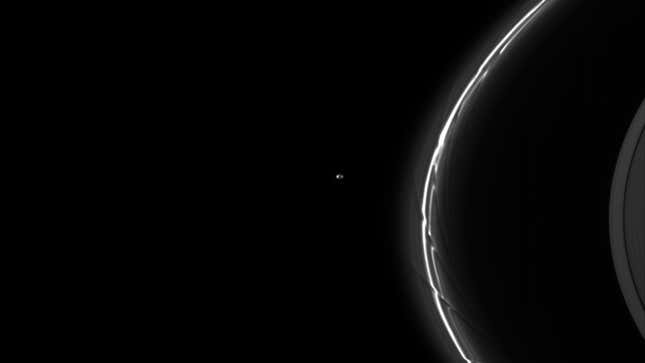A previously unknown satellite may be shaping the rings of Chariklo, a petite body that orbits the Sun between the orbits of Saturn and Uranus, according to a team of astronomers that recently simulated the rings’ dynamics.
Chariklo is about 160 miles (257.5 kilometers) across and is one of the Centaursa group of icy bodies between Jupiter and the ice giants Uranus and Neptune. Chariklo is the largest of these small bodiesmaking it similar to a large boulder the size of a small boulder as far as superlatives go. Chariklo also boasts two rings, discovered in 2013 and recently observed by the Webb Space Telescope.
Now, research published in The Planetary Science Journal suggests that a satellite may be confining Chariklo’s skimpy rings. “Planetary rings will naturally spread or disperse over time,” said Amanda Sickafoose, an astronomer at the Planetary Science Institute and the study’s lead author, in an institute release.
“Chariklo exhibits two thin rings, a few kilometers in width,” Sickafoose added. “In order for the rings to stay this thin, there needs to be a mechanism to confine the material and prevent it from dispersing.”

To model how a satellite could maintain Chariklo’s rings, the team conducted N-body simulations. In other words, they modeled the movement of millions of particles constituting the rings.
The team determined that a satellite orbiting Chariklo (which again, is 160 miles across) could have a diameter of about 3.73 miles (6 km). The idea that a shepherd moon could confine Chariklo’s rings had previously been suggestedbut now the idea is backed up by the recent simulations.
The team also determined that the Centaur’s rings are around—if not beyond—the Roche limit, the minimum distance from a body rings should form. Beyond the limit, ring material would simply be pulled into the moon by gravity.
“There has been significant research into the dazzling rings around the giant planets; however, the mechanisms of ring formation and evolution around small objects are not well understood,” Sickafoose said. “We’ve shown that one of the possibilities for thin rings to exist around small bodies is that they are being sculpted by a small satellite.”
More observations could reveal whether a satellite is indeed orbiting Chariklo, though no direct imagers in operation are capable of spotting it. If we are to resolve the mystery for good, it’ll take either indirect observations or an entirely new mission.
More: Incoming Visitor From the Oort Cloud Could Be Among the Largest Comets Ever Documented






